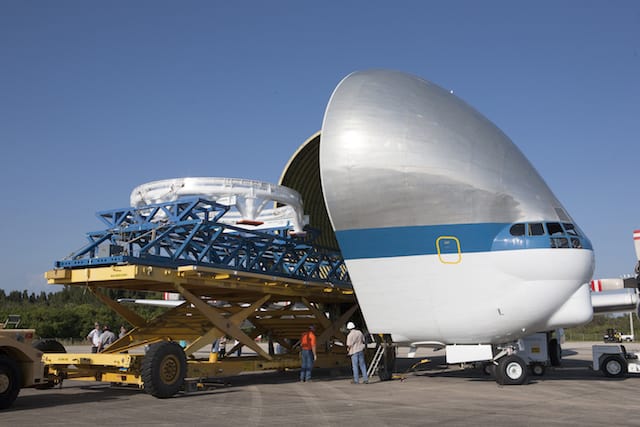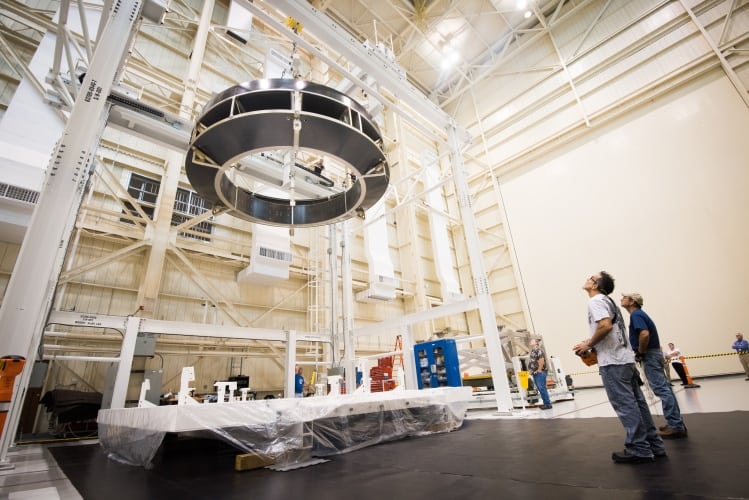The module has been built by Airbus Defence and Space for the European Space Agency, representing the first time that Europe has collaborated with NASA on a manned-capsule project.
A structural test model is a version of a spacecraft designed to examine the mechanical aspects of the design. It includes all the parts of the module that contribute to its overall integrity, including the frame and load-bearing elements but lacking, for example, the electrical connections.
The tests on this module at Plum Brook will include subjecting it on a vibration table – the largest of its kind in the world – to the shaking it will experience on lift-off, and also acoustic tests in a reverberating chamber equipped with over 30 powerful loudspeakers to simulate the shockwaves as it travels through the various layers of the atmosphere at supersonic speeds. This test will also simulate the effects of the launch abort system, a system of rocket engines that sits on top of the Orion module that can pull the craft away from the launcher to safety in an emergency.

Data from these tests will inform Airbus whether there are any areas of the module that need to be reinforced when actual flight model is built in time for the projected 2018 first full Orion mission.
Orion is a move away from the fully-reusable design philosophy of the Space Shuttle and back to an Apollo-like spacecraft, with a crew module (which is reusable) supported by an expendable service module.
The European Service Module (ESM) is the powerhouse for Orion, providing electricity and propulsion for the spacecraft as well as carrying the air and water for the crew during voyages into the vicinity of the Moon of around three weeks duration.
It is based on ESA’s Automated Transfer Vehicle (ATV), of which five were built to supply the International Space Station and also to provide a propulsion system to alter the ISS’s orbit.
‘You can think of it as basically the ATV, but without the cargo space,’ said Oliver Junkelhofel, Airbus programme manager.
The ATV was frequently known as the Space Truck and Orion will act as a ‘Space Taxi’; taking crew to the ISS and returning them home, as the Russian Soyuz system currently does. It is also the cornerstone of NASA’s plans to take humans beyond low Earth orbit, in the short term back to the Moon but with the eventual goal of journeying onwards to Mars.
The crew module (or Command Module) for Orion is being built by prime contractor Lockheed Martin, and its structural test model recently underwent testing itself at Plum Brook.
The first model destined for flight is currently under construction at Lockheed’s facility in Louisiana. Working on the interfaces between command and service modules was the most challenging part of the project, according to Mike Hawes, programme manager for Orion at Lockheed Martin.
‘We work together with Airbus as one team on this,’ he said, ‘but ensuring that all the systems work together has been demanding.’

In some senses the ATV was more complex than the ESM. It was capable of not only flying itself but also of docking automatically with the ISS. The ESM does not have its own on-board computers but relies on the Orion Command Module for processing.
This, said Junkenhofel, has necessitated a different approach for his team, working closely with his project partners in the US. ESM was not an independent project like ATV but necessarily closely interlinked with Lockheed Martin and NASA.
‘We have all the usual spaceflight challenges of reducing weight and certifying the systems, but we also have to handle the interfaces,’ he said. ‘Our experiences with the ISS have been very valuable here. That has proved we can work on complex, manned space projects with multiple partners, and it’s a model for this work.’
One complicating factor was the main engine for the ESM, which for reasons of budget control and minimising development time was an existing engine leftover from the Space Shuttle programme.
This engine had to be integrated into the design and placed within a system which also delivered fuel at varying pressures to a variety of different engines all over the spacecraft.
‘We haven’t done that variety of engines before, with the range of different pressures they need for main thrust and attitude adjustment; it’s based on proven and trusted technology, but this application is very new for us,’ Junkelhofel said.
The 2018 mission will be an unmanned trip into lunar orbit and a return to Earth. ESA is currently only contracted to provide the service module for this mission, but it already expects to supply service modules for subsequent manned missions and is planning accordingly. The agency has been invited to bid for these further projects, said ESA development head Nico Dettmann, although no final decision is expected until early in 2016.
‘But as far as we’re concerned in terms of planning, we’re part of the plan for going to Mars,’ said Junkenhofel.





Nanogenerator consumes CO2 to generate electricity
Nice to see my my views being backed up by no less a figure than Sabine Hossenfelder https://youtu.be/QoJzs4fA4fo